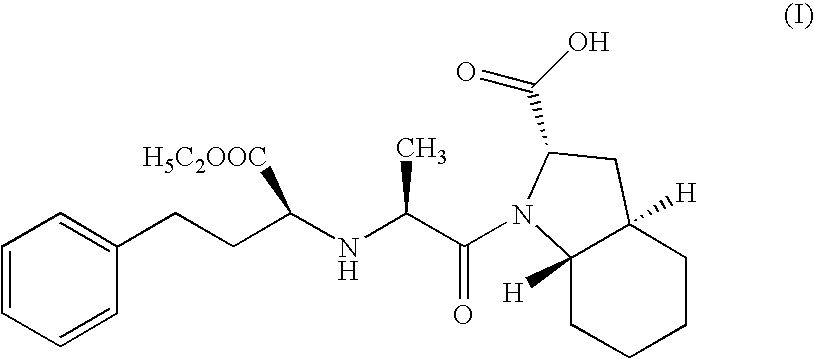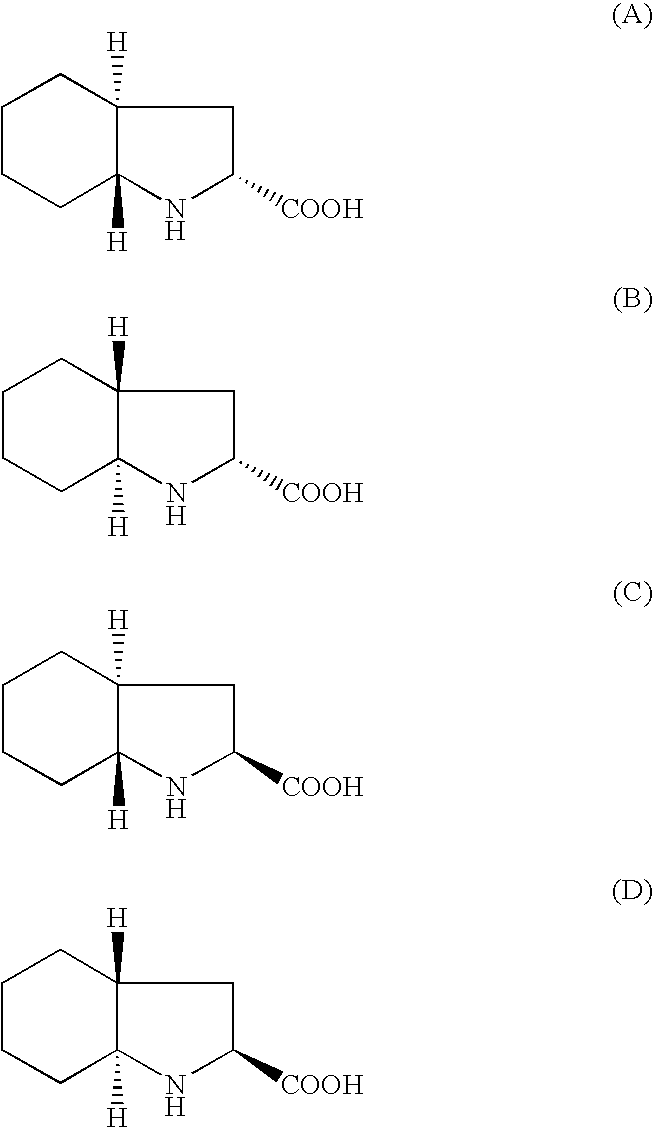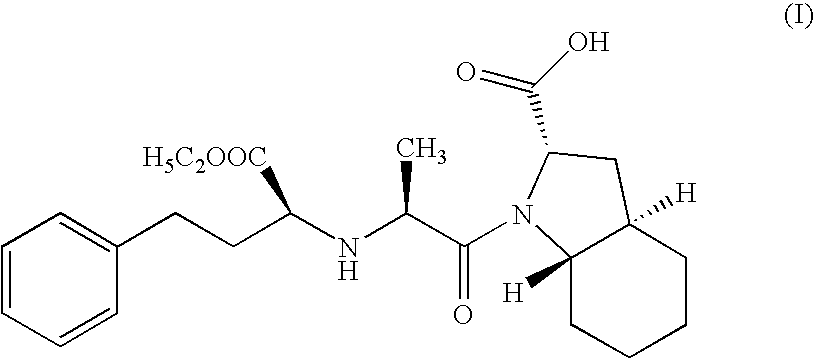Process for the synthesis of an ACE inhibitor
a technology of ace inhibitor and ace inhibitor, which is applied in the direction of heterocyclic compound active ingredients, drug compositions, cardiovascular disorders, etc., can solve the problems of low yield of product, inconvenient industrial scale up, and high sensitiveness of silyl-protected intermediates
- Summary
- Abstract
- Description
- Claims
- Application Information
AI Technical Summary
Benefits of technology
Problems solved by technology
Method used
Image
Examples
example 1
Step A: Preparation of N-[1-(S)-ethoxy carbonyl-3-phenyl propyl]-L-alanine N-carboxy anhydride (NCA)
[0056]Disodium dihydrogen phosphate dihydrate (177 gms; 0.994 moles) was dissolved in water (300 ml) at 35° C. and cooled to ambient temperature. Dichloromethane (250 ml) was charged and stirred for 15 mins. N-[1-(S)-ethoxy carbonyl-3-phenyl propyl]-L-alanine (106 gms; 0.381 moles) was added to the above solution and the reaction mass was cooled to 15° C. Solution of triphosgene (52.8 gms; 0.177 moles) dissolved dichloromethane (40 ml) was added dropwise to the reaction mass in 40 mins at 15-20° C. The reaction mass was further stirred for 30 min. Pyridine (0.5 ml; 0.006 moles) was added and the reaction mass was stirred for 1 hr at 15-20° C. The reaction mass was settled and layers were separated. Organic layer was washed with 2N HCl till the neutral pH obtained. The organic layer was further washed with water and dried over sodium sulphate. The solvent was evaporated to residue (110...
example 2
[0058]Racemic trans octahydro-1H-indole-2-carboxylic acid (65 gms; 0.384 moles) was stirred in dichloromethane (200 ml), triethyl amine (30 ml) was added under stirring at ambient temperature for 30 mins. N-[1-(S)ethoxy carbonyl-3-phenyl propyl]-L-alanine N-carboxyanhydride (67 gms; 0.23 moles) (prepared using procedure of Step A of Example 1) dissolved in dichloromethane 300 ml) was added dropwise to the reaction mass at ambient temperature and further stirred for 3 hrs. Water (500 ml) was added and the reaction mass was cooled to 15° C., pH of the reaction mass was adjusted to 4.2 using 2N HCl. The organic layer was separated. The organic layer was dried with sodium sulphate and concentrated to residue. The residue was dissolved in ethylacetate at reflux temperature. The reaction mass was cooled to ambient temperature. The resulting solid was filtered and dried under vacuum at 30-35° C. to get 34 gms of Trandolapril (HPLC purity 99.3%).
example 3
[0059]Racemic trans octahydro-1H-indole-2-carboxylic acid (100 gms; 0.592 moles) was stirred in dichloromethane (300 ml), triethyl amine (46 ml) was added under stirring at ambient temperature for 30 mins. N-[1-(S)-ethoxy carbonyl-3-phenyl propyl]-L-alanine N-carboxyanhydride (119 gms; 0.42 moles) (prepared using procedure of Step A of Example 1) dissolved in dichloromethane (300 ml) was added dropwise to the reaction mass at ambient temperature and further stirred for 3 hrs. Water (700 ml) was added and the reaction mass was cooled to 15° C., pH of the reaction mass was adjusted to 4.2 using 2N HCl. The organic layer was separated. The organic layer was dried with sodium sulphate and concentrated to residue. The residue was dissolved in ethylacetate at reflux temperature. The reaction mass was cooled to ambient temperature. The resulting solid was filtered and dried under vacuum at 30-35° C. to get 55 gms of trandolapril (HPLC purity 99.5%).
PUM
| Property | Measurement | Unit |
|---|---|---|
| temperature | aaaaa | aaaaa |
| temperature | aaaaa | aaaaa |
| pH | aaaaa | aaaaa |
Abstract
Description
Claims
Application Information
 Login to View More
Login to View More - R&D
- Intellectual Property
- Life Sciences
- Materials
- Tech Scout
- Unparalleled Data Quality
- Higher Quality Content
- 60% Fewer Hallucinations
Browse by: Latest US Patents, China's latest patents, Technical Efficacy Thesaurus, Application Domain, Technology Topic, Popular Technical Reports.
© 2025 PatSnap. All rights reserved.Legal|Privacy policy|Modern Slavery Act Transparency Statement|Sitemap|About US| Contact US: help@patsnap.com



